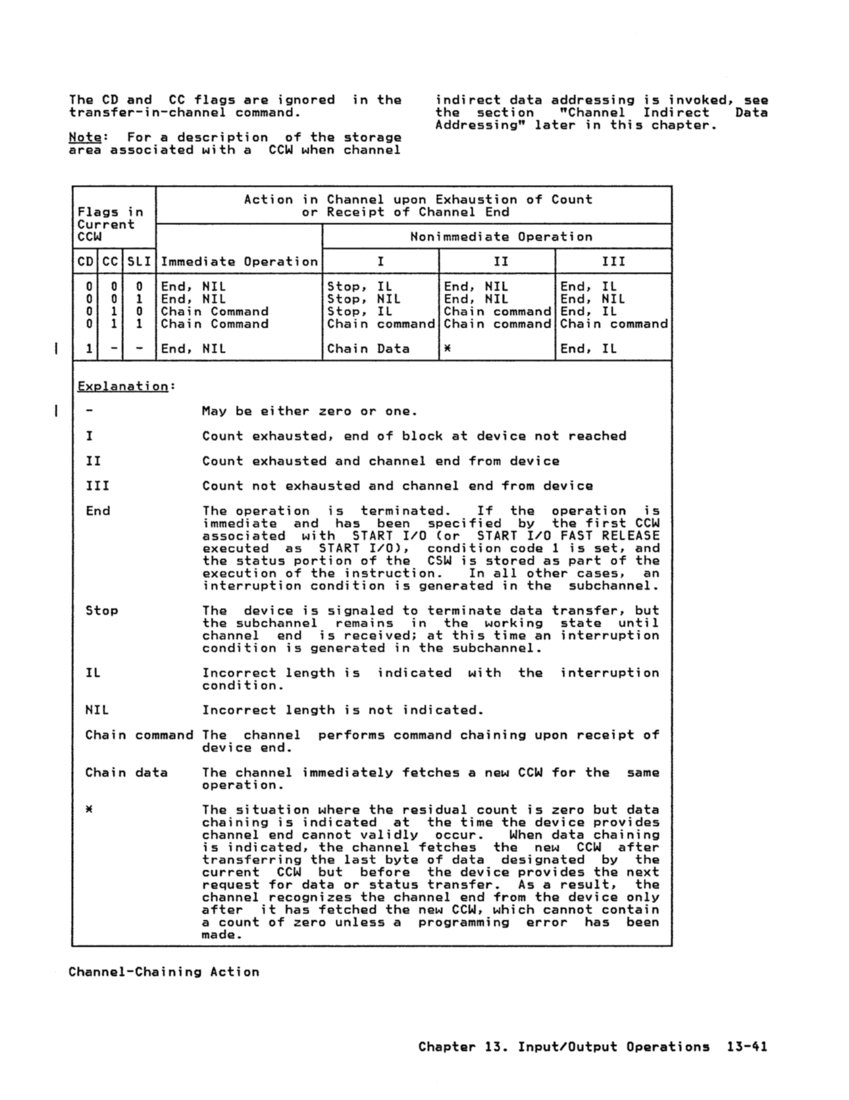The CD and CC flags are ignored in the
transfer-in-channel command.
indirect data addressing is invoked, see
the section"Channel Indirect Data
Addressing" later in this chapter.
Note: For a description of the storagearea associated with a CCW when channel
Flags inCurrent CCW CD CC SLI 0 0 0 0 0 1 0 1 0 0 1 1
1 --
Action inChannel upon Exhaustion of Count or Receipt of Channel End
Nonimmediate Operation
ImmediateOperation I II III
End, NILStop, IL End, NIL End, IL
End, NIL Stop, NIL End, NIL End, NILChain Command Stop, IL Chain command End, IL Chain Command Chain command Chain command Chain command
End, NILChain Data * End, IL
Explanation:
I
II
III
End
Stop
IL
NIL
May be either zero or one.Count exhausted, end of block at device not reached Count exhausted and channel end from device Count not exhausted and channel end from device
The operation is terminated. If the operation is
immediate and has been specified by the firstCCW associated with START I/O (or START I/O FAST RELEASE
executed as STARTI/O), condition code 1 is set, and
the status portion of theCSW is stored as part of the
execution of the instruction. In all other cases, an
interruption condition is generated in the subchannel.
The device is signaled to terminate data transfer, but
the subchannel remains in the working state until
channel end is received; at this time an interruption
condition is generated in the subchannel.
Incorrect length is indicated with the interruption
condition.
Incorrect length is not indicated.Chain command The channel performs command chaining upon receipt of
device end.Chain data The channel immediately fetches a new CCW for the same
operation.
The situation where the residual count is zero but data
chaining is indicated at the time the device provides
channel end cannot validly occur. When data chaining
is indicated, the channel fetches the newCCW after
transferring the last byte of data designated by the
currentCCW but before the device provides the next
request for data or status transfer. As a result, the
channel recognizes the channel end from the device only
after it has fetched the newCCW, which cannot contain
a count of zero unless a programming error has been
made.Channel-Chaining Action Chapter 13. Input/Output Operations 13-41
transfer-in-channel command.
indirect data addressing is invoked, see
the section
Addressing" later in this chapter.
Note: For a description of the storage
Flags in
1 --
Action in
Nonimmediate Operation
Immediate
End, NIL
End, NIL Stop, NIL End, NIL End, NIL
End, NIL
Explanation:
I
II
III
End
Stop
IL
NIL
May be either zero or one.
The operation is terminated. If the operation is
immediate and has been specified by the first
executed as START
the status portion of the
execution of the instruction. In all other cases, an
interruption condition is generated in the subchannel.
The device is signaled to terminate data transfer, but
the subchannel remains in the working state until
channel end is received; at this time an interruption
condition is generated in the subchannel.
Incorrect length is indicated with the interruption
condition.
Incorrect length is not indicated.
device end.
operation.
The situation where the residual count is zero but data
chaining is indicated at the time the device provides
channel end cannot validly occur. When data chaining
is indicated, the channel fetches the new
transferring the last byte of data designated by the
current
request for data or status transfer. As a result, the
channel recognizes the channel end from the device only
after it has fetched the new
a count of zero unless a programming error has been
made.















































































































































































































































































































































































































































































































































































